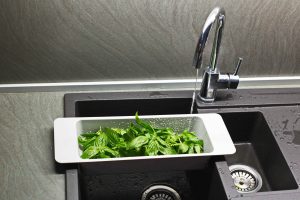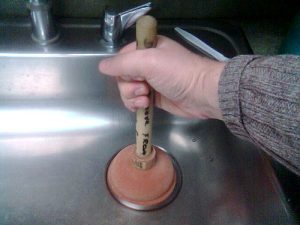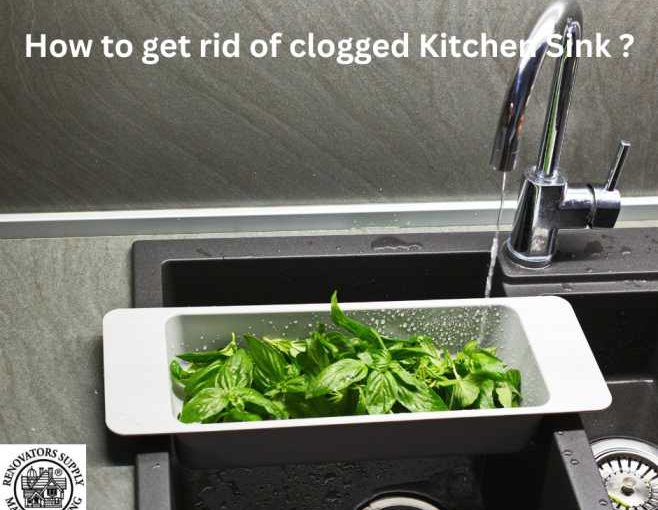It starts with a gurgle when the water goes down. Then your sink starts to fill up more slowly, the water taking longer and longer to drain. Before you know it, you have a full sink of cloudy, dirty water that absolutely refuses to budge no matter how long you let it sit. Yes, you’ve got yourself a good old-fashioned clogged kitchen sink, and now it’s staring back at you wondering “what are you going to do about me?”
A clogged sink is one of the most common plumbing issues in any home. Kitchen sinks in particular take a lot of abuse on a daily basis, and all that food debris, grease, hair, and gunk builds up over time leading to a blockage. But never fear – with a few simple tools, a little elbow grease, and these easy steps, you can have your sink sparkling and free-flowing again in no time.
Diagnose the Situation

Before you start unclogging anything, it’s good to try to get a sense of what’s causing the clog. Make sure all the sinks in your home are affected – if it’s just the kitchen sink, then the clog is likely in the kitchen pipes. Check whether the blockage is in the main sink basin or the separate side basin if you have one. Turn the sink on full blast and see if it even drains a little bit – a partial clog, for example, may still drain slowly rather than not at all. This will help you determine where to focus your unclogging efforts.
Gather Your Tools

Tackling a clogged sink is one of those jobs that requires having the right gear on hand. At a minimum, assemble the following tools:
- Plunger – get the type designed for sinks rather than toilets
- Bucket – preferably small enough to create a tight seal on the sink drain
- Drain cover – mesh screen or a sink stopper
- Mechanical snake or auger – preferably at least 6 feet long to get into pipes
- Protective goggles & work gloves
- Hot water
- Plumber’s putty or sealant (just in case)
Use a Sink Plunger

The classic, go-to unclogging method is to use a sink plunger. Fill the clogged sink basin with enough hot water to fully cover the drain opening. Place the plunger firmly over the drain hole to form a tight seal, then quickly plunge up and down with vigorous force at least 20 times. When pulling back, do so sharply to create suction down the pipes. Repeat more times if needed until water begins draining again.
For a double basin sink, plug the unused basin so all plunging force goes down one drain. If water starts to bubble up, you may be loosening the clog – keep going! Rinse hair and debris off the plunger periodically.
Try a Mechanical Snake

If plunging fails, it’s time to send in the snake! A mechanical drain auger works by physically snaking into pipes, latching onto the clog, then pulling it back out when retracted. Ensure the clog isn’t further down the main line by confirming other sinks don’t have the issue. Close the sink’s overflow plate stopper before feeding the auger down to prevent it from snaking that route. Crank the handle of your auger as you work 6-10 feet down the pipe until resistance is felt. Work back and forth at that clog spot, then slowly extract debris. Run hot water for a minute to flush remnants down.
Use a Chemical Treatment

For the toughest clogs that won’t relent, dissolvers may finish the job. These use powerful chemicals to eat through gunk and hair. Caustic soda crystals or foaming hydrogen peroxide mixtures are common recommendations, though wear gloves and read instructions carefully beforehand! Use a plunger after treatment to help kickstart drainage. Just be prepared for quite the nasty backsplash!
Prevent Future Clogs
They say prevention is the best medicine, and that’s certainly true when it comes to clogged sinks. Once you have a fresh free-flowing sink again, do what you can to keep it that way:
- Use a mesh drain cover to catch stray hair and food bits
- Limit pour fats, oils and grease down the sink – dispose in the trash instead
- Avoid pouring coffee grounds down the drain
- Consider rinsing dirty dishes in a prep sink or tub instead
- Clean pipes regularly using baking soda and vinegar
Unclogging a sink can seem daunting, but arm yourself with the right tools and some determination and it’s an easy DIY job. With some elbow grease and by steadily working through different methods, your water will drain freely once more. Then conduct regular maintenance to keep that sink clear and keep your scrubbing to just dirty dishes!
 1-800-659-2211 or International : 1-413-423-3300
1-800-659-2211 or International : 1-413-423-3300
